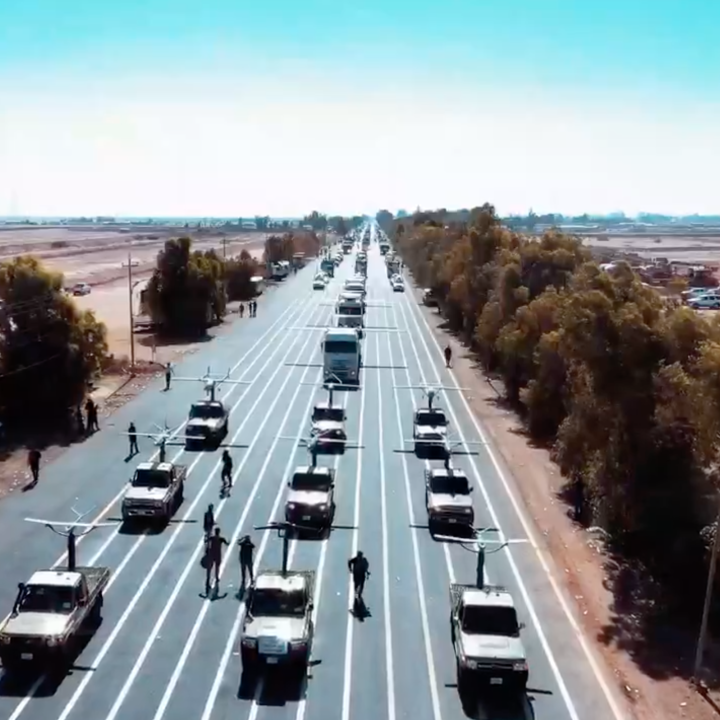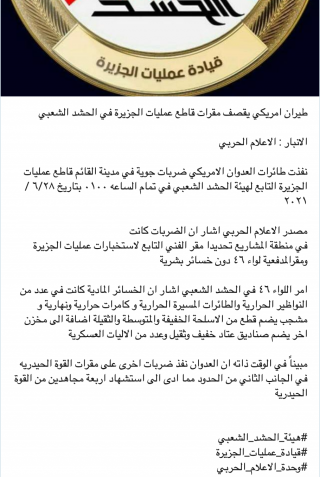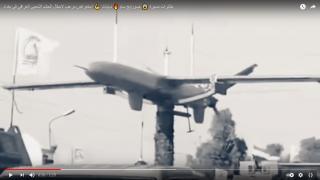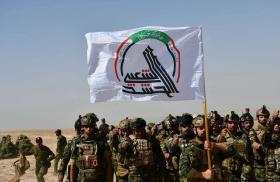
The Drones of Kataib Hezbollah's Jazira Command

KH-commanded militia units appear to have exclusive control over Iranian-provided drones, highlighting the group's links to Tehran and its involvement in recent UAV operations.
On June 26, the Commission for the Popular Mobilization Forces (PMF) (Hayat al-Hashd al-Shabi) staged a military parade at Camp Ashraf/Abu Muntadher al-Muhammadawi Camp in the Iraqi province of Diyala, displaying various types of (mainly Iranian-made) weaponry and equipment. Military drones, including the unmanned combat aerial vehicle Mohajer-6, were among these new weapons (Figure 1).
Drones Appear Exclusively Linked to KH Units of the PMF
During the parade, video shows that the Mohajer-6 and all other drones were paraded exclusively by PMF units under the control of Kataib Hezbollah (KH), namely, the Intelligence (Istikhabarat) Directorate and the Jazira Operations Command (JOC, or Qiyadat Amaliyat al-Jazira). Further illustrating KH's connection with the JOC, the only PMF units identified as being part of that command are the 45th, 46th, and 47th Brigades—all three of which are KH brigades.
On June 29, the Telegram account associated with the JOC posted an exclusive video of the drones displayed in the PMF parade, accompanied by a song with the lyrics, “This is the son of Kataib [Hezbollah].”
More evidence for JOC’s possession of drones emerges from the social media accounts of certain KH figures. One high-profile KH account published a photograph of the parade with the caption “The Jazira Operations Command, 45, 46 and 47 [PMF brigades] in the parade.” The post shows personnel with signature KH attire next to a Mohajer-6 (Figure 2).
The JOC and Kataib Hezbollah
The JOC’s area of operations mirrors KH's special area of responsibility around the Syrian border—the so-called "land bridge" between Iran, Iraq, Syria, and Lebanon. (Of note, U.S. and other airstrikes targeting KH and drone sites have fallen almost entirely within this area, at the al-Qaim end or the Jurf al-Sakhar end.) More specifically, the JOC area comprises two main areas:
1. The large Jurf al-Sakhar base complex, which encompasses numerous depopulated rural towns seized by the PMF in 2014-2015 and developed into a military and economic canton under KH's exclusive control. This area touches on numerous military industrial sites, some of which have been repurposed by KH for rocket and explosives production, testing, and storage.
2. A security zone in which KH is not the only ground-holding unit but has seniority. This zone stretches west to Nukhayb (on routes to Saudi Arabia and Syria), northwest to Rutbah, Akashat, and al-Qaim, then back down the Euphrates River to Amiriyah Fallujah and landing north of Lake Razazah. The east bank of the Euphrates appears to be used to bring rocket cells to the environs of al-Asad Air Base.
Interestingly, KH's JOC overlaps with the PMF's Anbar Operations Command headed by Qasim Muslih. The JOC’s statements on social media usually end with the hashtags #Hayat al-Hashd al-Shabi and #Qeyadat Amaliyat al-Jazira, indicating affiliation with the PMF but omitting mention of the Anbar Command (Figure 3).
Exploiting Links Between Iran, KH, the JOC, and Drones
A subject that requires further research is what this layering means: why is an additional overlapping command (and the attendant costs to Iraq) necessary, what level of the PMF does the JOC answer to, and what unique authorities does the JOC have? Iraqi officials, politicians, media outlets, and protestors might well ask these questions. If the JOC has a special mission, what is it, and who authorized it?
Moreover, if any of the drone types shown in the parade (or any drones with technical similarities) are used to attack targets in Iraq or Syria, there is credible evidence to support a KH nexus via the PMF Intelligence Directorate or the JOC. The Sahab drones (Figure 4) shown on June 26 do appear to have strong similarities to the U.S.-named KAS-04 fixed-wing drone systems used to attack U.S. bases on April 14 (Erbil), May 8 (al-Asad), May 11 (Kurdistan), and June 6 (al-Asad again).
Ergo, KH has implicated itself in these attacks, and also demonstrated a connection between the PMF and the attacks (via the ownership of such drones by the PMF Intelligence Directorate or JOC). International partners should seek to learn how the PMF procured the drones. If via the government of Iraq (unlikely), then Baghdad may have violated an arms embargo and purchased drones from sanctioned entities controlled by Iran's Islamic Revolutionary Guard Corps (IRGC).
If the PMF received these arms directly from Iran, this would still be a violation of the arms embargo by the Iraqi state, since the PMF is legally a state organ under the 2016 Law of the Hashd al-Shaabi. Moreover, if a PMF unit were to purchase such illegal arms without informing the government, this would also be a significant violation of the legal chain of command, punishable under Iraqi law.










